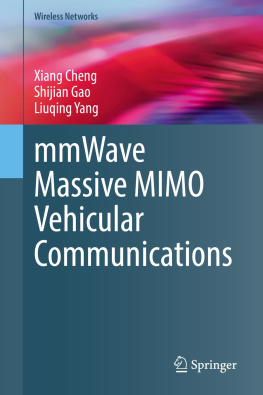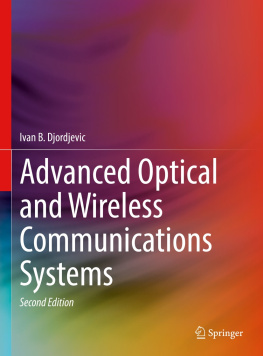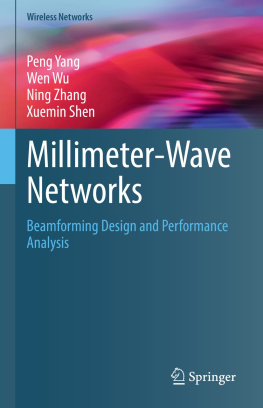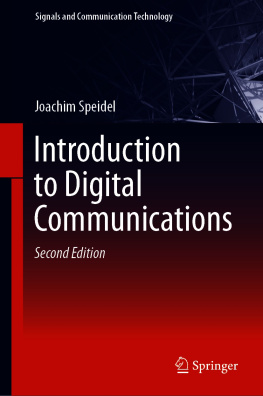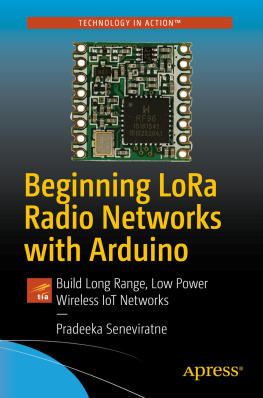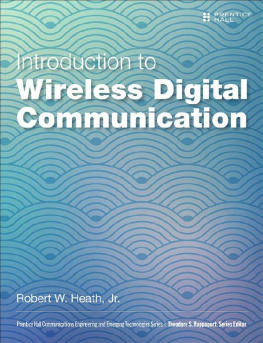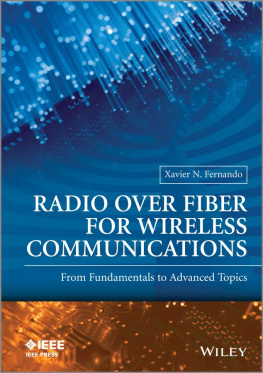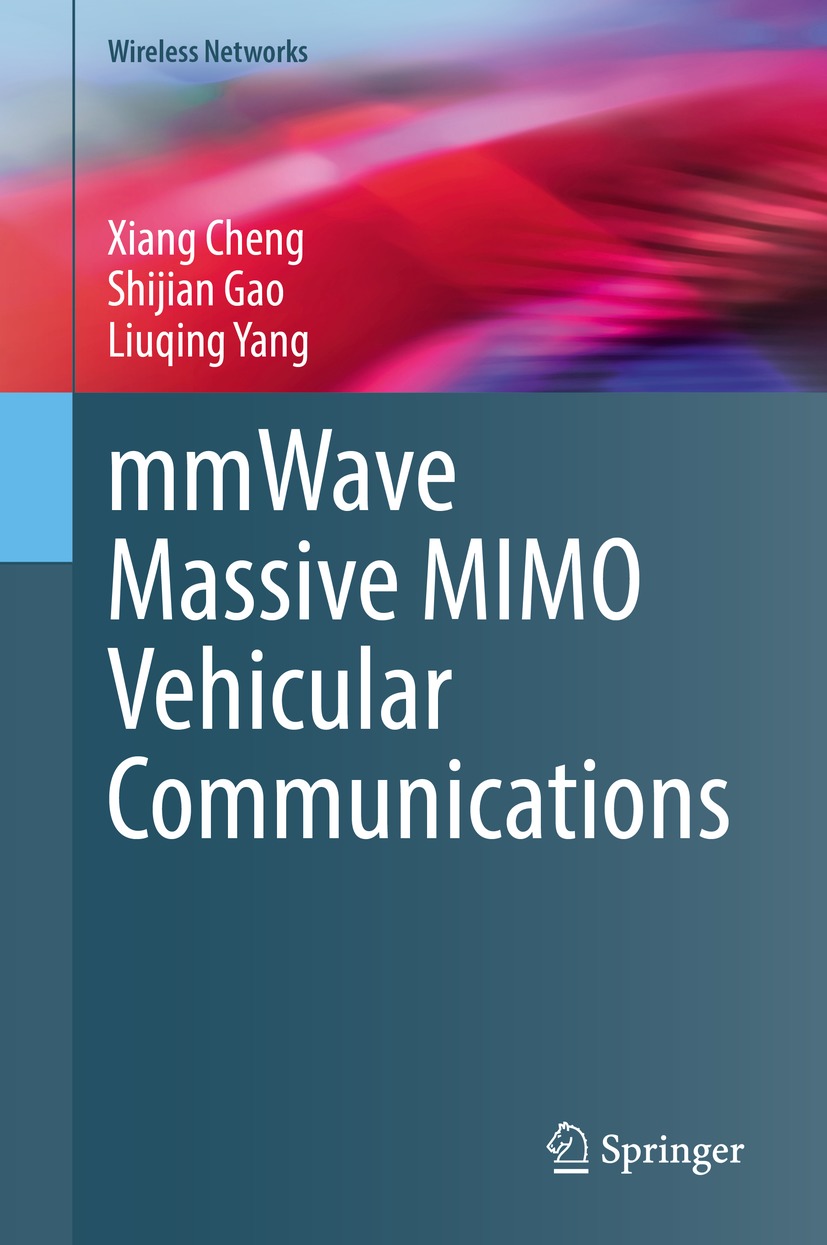Wireless Networks
Series Editor
Xuemin Sherman Shen
University of Waterloo, Waterloo, ON, Canada
The purpose of Springers Wireless Networks book series is to establish the state of the art and set the course for future research and development in wireless communication networks. The scope of this series includes not only all aspects of wireless networks (including cellular networks, WiFi, sensor networks, and vehicular networks), but related areas such as cloud computing and big data. The series serves as a central source of references for wireless networks research and development. It aims to publish thorough and cohesive overviews on specific topics in wireless networks, as well as works that are larger in scope than survey articles and that contain more detailed background information. The series also provides coverage of advanced and timely topics worthy of monographs, contributed volumes, textbooks and handbooks.
** Indexing: Wireless Networks is indexed in EBSCO databases and DPLB **
Xiang Cheng , Shijian Gao and Liuqing Yang
mmWave Massive MIMO Vehicular Communications

Logo of the publisher
Xiang Cheng
Peking University, Beijing, China
Shijian Gao
University of Minnesota, Minneapolis, MN, USA
Liuqing Yang
The Hong Kong University of Science and Technology, Guangzhou, Guangdong, China
ISSN 2366-1186 e-ISSN 2366-1445
Wireless Networks
ISBN 978-3-030-97507-4 e-ISBN 978-3-030-97508-1
https://doi.org/10.1007/978-3-030-97508-1
The Editor(s) (if applicable) and The Author(s), under exclusive license to Springer Nature Switzerland AG 2023
This work is subject to copyright. All rights are solely and exclusively licensed by the Publisher, whether the whole or part of the material is concerned, specifically the rights of translation, reprinting, reuse of illustrations, recitation, broadcasting, reproduction on microfilms or in any other physical way, and transmission or information storage and retrieval, electronic adaptation, computer software, or by similar or dissimilar methodology now known or hereafter developed.
The use of general descriptive names, registered names, trademarks, service marks, etc. in this publication does not imply, even in the absence of a specific statement, that such names are exempt from the relevant protective laws and regulations and therefore free for general use.
The publisher, the authors, and the editors are safe to assume that the advice and information in this book are believed to be true and accurate at the date of publication. Neither the publisher nor the authors or the editors give a warranty, expressed or implied, with respect to the material contained herein or for any errors or omissions that may have been made. The publisher remains neutral with regard to jurisdictional claims in published maps and institutional affiliations.
This Springer imprint is published by the registered company Springer Nature Switzerland AG
The registered company address is: Gewerbestrasse 11, 6330 Cham, Switzerland
Preface
The automobile industry is currently shifting from driving by humans to driving by intelligence. Such a transformative evolution is primarily propelled by fast-increasing onboard sensors, with which the vehicles are gaining unprecedented degrees of intelligence. Numerous sensors will inevitably bring in massive sensory data, making reliable and swift information transfer an urgent and crucial issue. Existing wireless solutions include DSRC and LTE-V2X, both permitting low-volume message delivery. However, due to the limited bandwidth, they are still far from meeting the Gbps-level data rate regulated by the automobile industry. The current limitation inevitably motivated the exploration of the mmWave band, where vast spectrum resources are available for high-speed information transfer. Besides the bandwidth merit, mmWaves inherent short wavelength allows a natural combination with massive MIMO for higher diversity and multiplexing gain. In theory, alternating the operating frequency does not need to change the wireless regime, but the fact is that many implementing concerns, such as power consumption and hardware expenditure, prohibit mmWave systems from inheriting classic fully-digital transceivers. Instead, an economical yet restricted structure, namely the hybrid beamformer, comes into practical use. In conjunction with the higher signal dimensions and complicated channel environments, the compromised hardware architecture requires a paradigm-shifting design to underpin mmWave communication. Against this background, this book will showcase a comprehensive picture regarding advanced mmWave massive MIMO techniques, hoping to provide promising physical-layer solutions to vehicular communications in the 5G and Beyond era.
The book is organized as follows. Chapter spotlights on downlink multi-user transmission. Despite our best effort, the above content covers just a tip of the iceberg of mmWave vehicular communication. Thus, some open problems and promising directions will be discussed at the end of each chapter for future studies.
This book is mainly oriented to researchers, graduated students, and professors relevant to this field. Nevertheless, it also serves as a great introduction to state-of-the-art mmWave vehicular communications for those outside this field but aspire to pursue new interdisciplinary directions.
We would like to thank Ms. Yajun Fan, Mr. Ziwei Huang, and Mr. Zonghui Yang for their inspiring discussions on the research work presented in this book. Finally, we would like to thank the continued support from the National Natural Science Foundation of China under Grant 62125101 and the National Science Foundation under Grants ECCS-2102312 and CNS-2103256.
Xiang Cheng
Shijian Gao
Liuqing Yang
Beijing, China Minneapolis, MN, USA Guangzhou, China
Acronyms
3GPP
The 3rd Generation Partnership Project
ADC
Analog-to-Digital Converter
APEP
Average Pairwise Error Probability
APS
Analog Phase Shifter
BER
Bit Error Rate
BS
Base Station
CDL
Clustered Delay Line
CP
Cyclic Prefix
CS
Compressed Sensing
D2D
Device-to-Device
DAC
Digital-to-Analog Converter
DSRC
Dedicated Short-Range Communications
FFT
Fast Fourier Transform
GMD
Geometric Mean Decomposition
GPS
Global Positioning System
IFFT
Inverse Fast Fourier Transform
IM
Index Modulation
ITS
Intelligent Transportation System
IV
Internet of Vehicles
LTE
Long-Term Evolution
MIMO
Multiple-Input Multiple-Output
MS
Mobile Station
NMSE
Normalized Mean Square Error
NR
New Radio
OFDM
Orthogonal Frequency Division Multiplexing
OMP
Orthogonal Matching Pursuit
PSD
Power Spectrum Density
QoS
Quality of Service
RF
Radio Frequency
RSU
Roadside Unit
SM
Spatial Modulation
SNR
Signal-to-Noise Ratio
SVD
Singular Value Decomposition
TDL
Tapped Delayed Line
UE
User Equipment
V2V
Vehicle-to-Vehicle
V2X
Vehicle-to-Everything
VANET
Vehicular Ad hoc Network
VCN
Vehicular Communication Network
Contents

